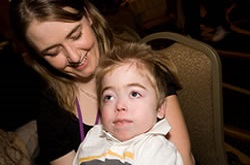What is GM1 gangliosidosis?
Gangliosidosis-1 (GM-1) is a progressive neurological genetic disorder caused by the absence of a vital enzyme. It is one of over 50 genetically inherited disorders known as Lysosomal Storage Diseases.
Dr. Landing gave the first definitive description of Gangliosidosis-1 (GM-1) in 1964, which had variously been called "Hurler variant," "pseudo-Hurler disease," and "Tay-Sachs with visceral involvement."
Dr. Caffey likely gave the earliest description of GM-1 in 1951 discussing prenatal onset of Hunter-Hurler disease.
What are the GM1 gangliosidosis symptoms?
Symptoms can appear anytime from birth to adulthood and differ depending on the age.
GM1 - Infantile Symptoms & Diagnosis
Symptoms appear within the first 6 months of age and may be apparent at birth. Early symptoms include poor appetite, weak suck and failure to thrive. Only about 50% of cases display the cherry-red spot in the back of the eye.
GM1 - Juvenile Symptoms & Diagnosis
Symptoms appear after the first year of life, typically between ages 2 and 5, but can occur anytime during childhood. Early symptoms of GM1 include lack of coordination or clumsiness and muscle weakness such as struggling with stairs. A child may also exhibit slurred speech, swallowing difficulties and muscle cramps.
GM1 - Late Onset Symptom & Diagnosis
Symptoms typically appear in adolescence or early adulthood, but sometimes later. Early symptoms of Late Onset GM1 include clumsiness and muscle weakness in the legs. Once diagnosed, adults often reflect back to their childhood and may notice experiencing symptoms much earlier such as not being athletic and/or speech difficulties or a stutter as a child or teenager.
What causes GM1 gangliosidosis?
Gangliosidosis-1 GM1 disease is caused by the absence or significantly reduced level of a vital enzyme called beta-galactosidase (GLB1). Without GLB1, a fatty substance or lipid called GM-1 ganglioside accumulates abnormally in cells, especially in the nerve cells of the brain. This ongoing accumulation, also called "substrate", causes progressive damage to the cells.
The Juvenile and Late Onset forms of GM-1 occur when the mutations allow the GLB1 enzyme to function a little bit. Just a small increase in GLB1 activity is enough to delay the onset and slow the progression of symptoms.
Read More
Who can inherit GM1 gangliosidosis?
GM 1 gangliosidosis must be inherited from parents who are carriers of the disease. Anyone can be a carrier of GM1 gangliosidosis and not have any symptoms. When both parents are carriers, each child has a 25% of having the disease. The carrier rate for the general population is 1/250. Some evidence suggests people of Irish / British Isle descent have an increased risk over the general population between 1/50 to 1/150. French Canadians, Louisiana Cajuns and Ashkenazi Jews are all considered high risk with a carrier rate of 1/27.
Talk to your doctor about Genetic Counseling to discuss your options before starting your family.
What research is being done on GM1 gangliosidosis?
To date, there is no treatment or cure for GM-1 disease but there is exciting, ongoing research and NTSAD is committed to funding and supporting the efforts to finding a cure while helping families to cope with GM1.
GM1 shares biochemical traits with other diseases including Tay-Sachs and Sandhof, thus research on any of these diseases may benefit the others. Treating these diseases falls into two general categories: restoring the missing enzyme or decreasing the waste accumulation. The scientific community generally agrees that no single therapy will cure these diseases but that rather a combination of approaches will slow, halt and even reverse the damage caused by these diseases.
Research has included Gene Therapy, Molecular Chaperone, Substrate Inhibition, Stem Cells, and Bone Marrow Treatment.
Support: Coping with GM1
NTSAD is the largest organization dedicated to supporting families with members having GM1, Sandhoff, Tay-Sachs or Canavan disease. We have compiled many resources for family members, provide weekly and monthly updates on events and research, and organize an annual family conference specifically for family members.
Family support web pages are grouped based on the age of the family member having the disease.
GM1 Family Information Packet
Someone you love has been diagnosed with a disease without a treatment or cure. You don't know what to do. NTSAD offers a free information packet that includes materials on;
- symptom management
- research updates
- how to cope
Request it today by completing our online request form: Contact Us.
More GM1 Online Resources
U.S. National LIbrary of Medicine
Genetics Home Reference: GM1 Gangliosidosis
National Center for Biotechnology Information
Gangliosidosis generalized GM1 type 1 - infantile
Gangliosidosis generalized GM1 type 2 - juvenile
Gangliosidosis GM1 type 3 - adult
Medical Publications on GM1
U.S. National Institute of Health
GM1 Gangliosidosis Clinical Trials
Genetic & Rare Disease Info Center, GM1 type 1 - infantile
Genetic & Rare Disease Info Center, GM1 type 2 - juvenile
Genetic & Rare Disease Info Center, GM1 type 1 - adult
Genetic Alliance disease research
Gangliosidosis GM1
Gangliosidosis generalized GM1 type 1 - infantile
Gangliosidosis generalized GM1 type 2 - juvenile
Gangliosidosis GM1 type 3 - adult
Orphanet, Online Rare Disease & Orphan Drugs
GM1 Summary and Online Resources
OMIM database of of human genes and genetic phenotypes
Gangliosidosis generalized GM1 type 1 - infantile
Gangliosidosis generalized GM1 type 2 - juvenile
Gangliosidosis GM1 type 3 - adult


